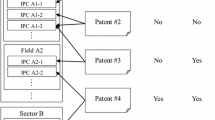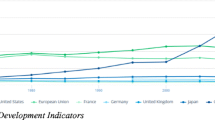Abstract
Exploring and measuring technology-relatedness and its collateral technology divergence and convergence, would have far-reaching theoretical significance and academic value on the chain mode of technology development, and also on the mastery of the laws for technology evolution and progress. Taking the patentometric analysis of solar energy technology worldwide as a case, employing the methodology of technology co-classification analysis, choosing two indicators, namely, mean technology co-classification partners (MTCP) and mean technology co-classification index (MTCI), we have analyzed and measured the evolving process of technology-relatedness. The results not only demonstrate in a direct manner the continuously advancing character of solar energy technology in the tensions of technology divergence and convergence, but also reveal quantitatively that, due to the chain reaction of technology-relatedness, technology divergence and technology convergence would tend to evolve in parallel. Through these, it is indicated that technology divergence and technology convergence are two trends which would develop separately, react mutually, and serve as causation for each other, thus making chain progress and continuously pushing forward the innovation, creation and upgrading of technologies. This is a regular phenomenon on condition that the specific technology area is in a status of sustainable development. It still awaits further research on how to verify and reveal the general principles on the interaction between technology divergence and convergence by conducting empirical studies and combining patent analysis.





Similar content being viewed by others
References
Benner, M., & Waldfogel, J. (2008). Close to you? Bias and precision in patent-based measures of technological proximity. Research Policy, 37(9), 1556–1567.
Berkovski, B., & Gottschalk, C. M. (1997). Strengthening human resources for new and renewable energy technologies of the 21st century—UNESCO engineering education and training programme. Renewable Energy, 10(2–3), 441–450.
Breschi, S., Lissoni, F., et al. (2003). Knowledge-relatedness in firm technological diversification. Research Policy, 32(1), 69–87.
Chase, R., & Borgatti, S. (2013). Analytic Technologies-Ucinet. http://www.analytictech.com/downloaduc6.htm. Accessed 16 Feb 2013.
Chen, C. (2010). CiteSpace: 2003–2010. http://cluster.cis.drexel.edu/~cchen/citespace/. Accessed 16 March 2011.
Chen, C. (2013). CiteSpace: 2003–2013. http://cluster.cis.drexel.edu/~cchen/citespace/. Accessed 16 March 2013.
Chen, Y. L., & Chiu, Y. T. (2011). An IPC-based vector space model for patent retrieval. Information Processing and Management, 47(3), 309–322.
Curran, C. S., & Leker, J. (2011). Patent indicators for monitoring convergence—examples from NFF and ICT. Technological Forecasting and Social Change, 78(2), 256–273.
de Moura, A. M. M., & Caregnato, S. E. (2010). Co-classification between articles and patents: a study of the interaction between S & T on Brazilian Biotech. Informacao and Sociedade-Estudos, 20(2), 119–132.
Garcia, C. Q., & Velasco, C. A. B. (2010). Technological relatedness in interfirm cooperation agreements and the generation of innovations. Cuadernos De Economia Y Direccion De La Empresa, 13(45), 43–67.
Green, M. A. (1997). Brain sport: the 1996 world solar challenge solar car race across Australia. Progress in Photovoltaics, 5(1), 69–76.
Hussinger, K. (2010). On the importance of technological relatedness: SMEs versus large acquisition targets. Technovation, 30(1), 57–64.
Jaffe, A. (1986). Technological opportunity and spillovers of R&D: evidence from firms’ patents, profits and market value. American Economic Review, 76(5), 984–999.
Jaffe, A., & Trajtenberg, M. (1999). International knowledge flows: evidence from patent citations. Economics of Innovation and New Technology, 8(1/2), 105–163.
Jang, S. L., Chen, L. J., et al. (2013). Innovation and production in the global solar photovoltaic industry. Scientometrics, 94(3), 1021–1036.
Joo, S. H., & Kim, Y. (2010). Measuring relatedness between technological fields. Scientometrics, 83(2), 435–454.
Jun, S. (2013). A new patent analysis using association rule mining and Box-Jenkins modeling for technology forecasting. Information-an International Interdisciplinary Journal, 16(1B), 555–562.
Koo, O. K., Mertz, A. W., et al. (2013). Analysis of microbial diversity on deli slicers using polymerase chain reaction and denaturing gradient gel electrophoresis technologies. Letters in Applied Microbiology, 56(2), 111–119.
Kotnour, T., & Bollo, T. R. (2011). Strategic management of a transformation in a multi-program technology program involving convergence and divergence of programs: observations from NASA. International Journal of Technology Management, 53(2–4), 257–272.
Kuhn, T. (1977). The essential tension: selected studies in scientific tradition and change. Chicago: University of Chicago Press.
Kumar, P., Park, S. H., et al. (2013). Multiwavelength study of a solar eruption from AR NOAA 11112 I. Flux emergence, sunspot rotation and triggering of a solar flare. Solar Physics, 282(2), 503–521.
Lawson, M., Kemp, N., et al. (1996). Automatic extraction of citations from the text of English-language patents—An example of template mining. Journal of Information Science, 22(6), 423–436.
Leitch, M. E., Casman, E., et al. (2012). Nanotechnology patenting trends through an environmental lens: analysis of materials and applications. Journal of Nanoparticle Research, 14(12), 23.
Leten, B., Belderbos, R., et al. (2007). Technological diversification, coherence, and performance of firms. Journal of Product Innovation Management, 24(6), 567–579.
Leydesdorff, L. (2008a). On the normalization and visualization of author co-citation data: Salton’s cosine versus the Jaccard index. Journal of the American Society for Information Science and Technology, 59(1), 77–85.
Leydesdorff, L. (2008b). Patent classifications as indicators of intellectual organization. Journal of the American Society for Information Science and Technology, 59(10), 1582–1597.
Linhares, D. C. L., Rovira, A., et al. (2012). Evaluation of Flinders Technology Associates cards for collection and transport of samples for detection of porcine reproductive and respiratory syndrome virus by reverse transcription polymerase chain reaction. Journal of Veterinary Diagnostic Investigation, 24(2), 328–332.
Liu, Z., & Wang, H. (1985). On technology developing model. Studies in Science of Science, 3(4), 10–23.
Luan, C., Hou H., et al. (2012). Mapping the evolution of technology network in the field of solar energy technology. 17th International Conference on Science and Technology Indicators (STI), Montreal, Quebec, Canada.
Magerman, T., Van Looy, B., et al. (2010). Exploring the feasibility and accuracy of latent semantic analysis based text mining techniques to detect similarity between patent documents and scientific publications. Scientometrics, 82(2), 289–306.
Mowery, D. C., Oxley, J. E., et al. (1998). Technological overlap and interfirm cooperation: implications for the resource-based view of the firm. Research Policy, 27(5), 507–523.
Noruzi, A., & Abdekhoda, M. (2012). Mapping Iranian patents based on International Patent Classification (IPC), from 1976 to 2011. Scientometrics, 93(3), 847–856.
Peng, J. Q., Lu, L., et al. (2013). Review on life cycle assessment of energy payback and greenhouse gas emission of solar photovoltaic systems. Renewable and Sustainable Energy Reviews, 19, 255–274.
Persson, O. (2013). Bibexcel. http://www8.umu.se/inforsk/Bibexcel/. Accessed 20 March 2013.
Shin, D. H. (2010). Convergence and divergence: policy making about the convergence of technology in Korea. Government Information Quarterly, 27(2), 147–160.
Spasser, M. A. (1997). Mapping the terrain of pharmacy: co-classification analysis of the international pharmaceutical abstracts database. Scientometrics, 39(1), 77–97.
Steensma, H. K., Howard, M., et al. (2012). The compensatory relationship between technological relatedness, social interaction, and knowledge flow between firms. Strategic Entrepreneurship Journal, 6(4), 291–306.
Stepanova, K. (2013). Development of Solar Energy Technologies. from http://www.eere.energy.gov/basics/renewable_energy/solar.html. Accessed 06 Feb 2013.
Sternitzke, C. (2009). Defining triadic patent families as a measure of technological strength. Scientometrics, 81(1), 91–109.
Thomson Reuters, T. (2012). Derwent innovations index. http://thomsonreuters.com/products_services/intellectual_property/ip_products/a-z/derwent_innovations_index/#tab2.s. Accessed 16 Sep 2012.
Tijssen, R. J. W. (1992). A quantitative assessment of interdisciplinary structures in science and technology—co-classification analysis of energy research. Research Policy, 21(1), 27–44.
Tseng, Y. H., Lin, C. J., et al. (2007). Text mining techniques for patent analysis. Information Processing and Management, 43(5), 1216–1247.
Tylecote, A. (1998). Technical change and the world economy: convergence and divergence in technology strategies. R and D Management, 28(1), 57–58.
Wang, X. W., Zhang, X., et al. (2011). Patent co-citation networks of fortune 500 companies. Scientometrics, 88(3), 761–770.
WIPO. (2011). Intellectual property statistics. http://www.wipo.int/ipstats/en/. Accessed 16 June 2012.
Zhao, J., Wang, A., et al. (1997). 20,000 PERL silicon cells for the 1996 world solar challenge solar car race. Progress in Photovoltaics, 5(4), 269–276.
Acknowledgments
The research was supported by the Natural Science Foundation of China (NSFC) under Grant 71073015 and 71103022; also Major Project of the National Social Science Fund of “Ethical issues of high-tech” under Grant No. 12&ZD117.
Author information
Authors and Affiliations
Rights and permissions
About this article
Cite this article
Luan, C., Liu, Z. & Wang, X. Divergence and convergence: technology-relatedness evolution in solar energy industry. Scientometrics 97, 461–475 (2013). https://doi.org/10.1007/s11192-013-1057-x
Received:
Published:
Issue Date:
DOI: https://doi.org/10.1007/s11192-013-1057-x




